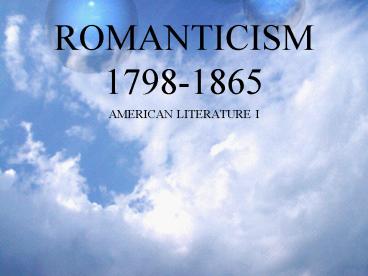ROMANTICISM 17981865 PowerPoint PPT Presentation
1 / 45
Title: ROMANTICISM 17981865
1
ROMANTICISM1798-1865
- AMERICAN LITERATURE I
2
RomanticismWhat does this term mean?
3
An interesting question, since Romanticism
cannot be given just one final definition. It is
too large and varied a literary, cultural,
philosophical, and artistic movement.
4
A convenient date that is often given (and
remember these dates are just approximationsnothi
ng is ever this neat and simple) is 1798 with the
publication of Coleridges and Wordsworths
Lyrical Ballads, and ending in America in 1865,
the close of the Civil War.
5
CHARACTERISTICS OF ROMANTICISM1. Revolution
6
2. The importance of the individual as opposed
to the importance of society.
7
3. From a focus on man to a focus on the world.
8
4. The importance of individual feeling.
9
5. The sublime (the Noble Savage is a good
example as is nature, or Poes conception of the
archetypal female.
10
6. The manifestation of God in nature.
11
7. Human Imagination as revealing truth as
opposed to Reason revealing truth.
12
8. An interest in the ancient and strange.
13
9. A rejection of all social institutions.
14
WHAT DOES ALL THIS MEAN?
15
1. Romanticism is a SHIFT in human
consciousness that occurred late in the 18th
century. A profound shift that turned away from
the Rationalism of the Neoclassic era or Age of
Reason.
16
Romanticism rejected human reason as a means
of measuring and ordering human experience, and
turned instead toward the free play of the
IMAGINATION and the power of the imagination as
an instrument toward true insight,
17
experience, and understanding of the
complexities of existence. Romanticism is so
complex and varied that it is almost impossible
to pin down. However, there are some useful
generalities that can be drawn
18
1. It places new emphasis on imagination,
on feeling, on the value of the primitive, and
especially a narrowing of outlook from the
universal to the particular, from humankind or
man to a nation or ethnic viewpoint.
19
2. It rejects all organized institutions and
sees in them fetters to shackle and control man,
not free himthe church, tyrannical governments,
educational propaganda, etc.
20
3. Progress is an illusion that is destroying
the world, not advancing it.
21
4. Scientific rationality is far inferior to
truly understanding human experience than is
human imagination.
22
5. It seeks the Sublime ultimate beauty and
perfection, usually most exemplified by Nature.
23
6. The individual is most important in finding
significance in ones own existence. Ethical
behavior comes from the self, not from an
organized institution.
24
7. The supernatural is important in interpreting
reality.
25
8. It seeks to recognize the value of all human
beings women, children, minorities.
26
9. Revolution against anything felt to be
oppressive.
27
Following are several paintings by various
artists from diverse nationalities that reflect
the preceding discussion.
28
Caspar David Friedrich 1829. Oak Tree. German.
29
(No Transcript)
30
Kenilworth Castle 1830 J. M. W. Turner
31
(No Transcript)
32
The Nightmare 1781 Henry Fuseli. Swiss.
33
(No Transcript)
34
Liberty Leading the People
35
(No Transcript)
36
Neptunes Horses Walter Crane
37
(No Transcript)
38
Echo Flying From Narcissus 1795-98 Guy Head.
English.
39
(No Transcript)
40
Eve. Auguste Rodin 1881. French.
41
(No Transcript)
42
La Ghirlandata. Woman as Sublime
43
(No Transcript)
44
The Circle of the Lustful. Paolo and Francesca.
1824. William Blake. English
45
(No Transcript)

